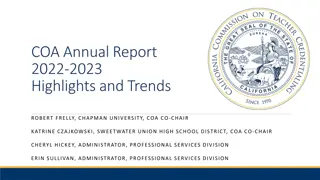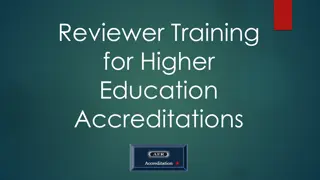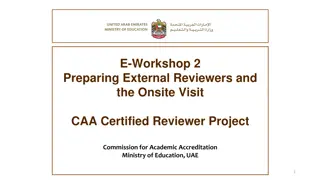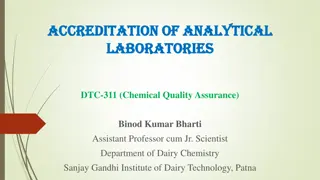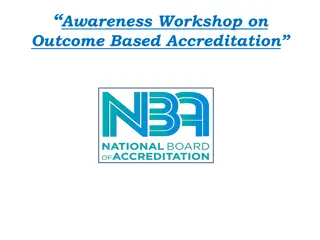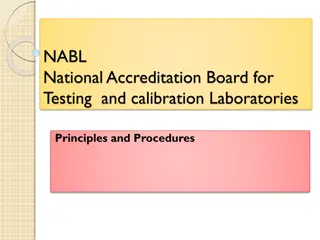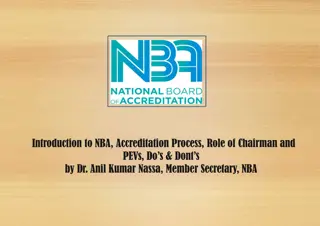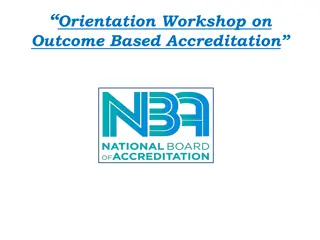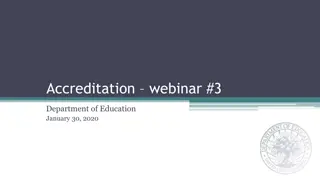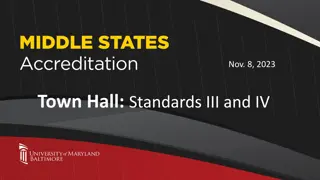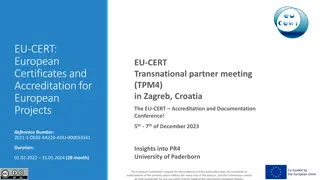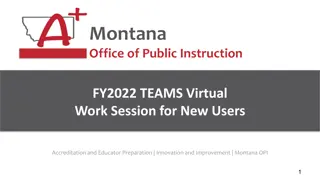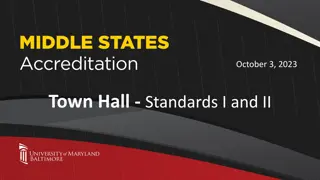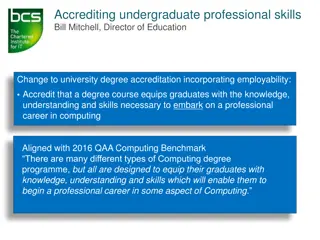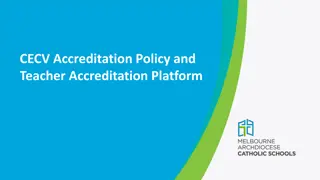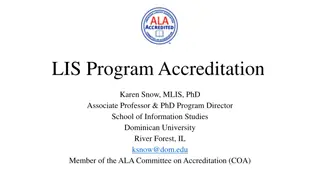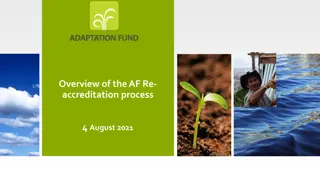Understanding IACET Accreditation for Continuing Education Programs
The International Association for Continuing Education & Training (IACET) accredits programs like ASSP to ensure excellence in instructional practices. Criteria involve clear learning outcomes, evaluation methods, and a proper learning environment. To get approved for awarding CEUs, ASSP communities must follow guidelines and submit necessary documentation. Responsibilities include needs assessment, developing objectives, program design, selecting speakers, and event evaluation.
Download Presentation

Please find below an Image/Link to download the presentation.
The content on the website is provided AS IS for your information and personal use only. It may not be sold, licensed, or shared on other websites without obtaining consent from the author. Download presentation by click this link. If you encounter any issues during the download, it is possible that the publisher has removed the file from their server.
E N D
Presentation Transcript
Community CEU Program Update Wes Lashbrook, CSP, CIH, Area Director, Area 2
What Is IACET Accreditation? The International Association for Continuing Education & Training IACET auditors review ASSP s educational content and supporting processes. Yearly self-audits to maintain accreditation, a full renewal process happens every 5 years. 2
IACET Accreditation ASSP is accredited by the International Association for Continuing Education and Training (IACET). The ANSI/IACET standard that is recognized internationally as a standard of excellence in instructional practices. ASSP is accredited to issue the IACET CEU. ASSP has a responsibility to provide education that adheres to the IACET standard. ASSP communities must ensure that all requirements are satisfied for educational programs. 3
Criteria set forth by the ANSI/IACET: Each activity for audience educational needs Each activity has a clear and concise written statement with learning outcomes (objectives). Need to know what you are talking about. Instructional methods meet learning outcomes. Participants demonstrate measurable understanding of objectives. 4
Criteria set forth by the ANSI/IACET Part two: Each learning activity is evaluated Each instructor defined responsibilities for learning objectives. The group has a review process to ensure CEU criteria are met. The group maintains a complete record of everyone's participation for a period > seven years. The group provides an appropriate learning environment 5
How Can Communities Programs Get Approved to Award CEU s? Be a member of ASSP in good standing Timely submission Supporting documentation Application at www.assp.org/ceu-application 6
Responsibility ASSP Community Shared Responsibility Conducting needs assessment Developing learning objectives Design the program Select speakers Fill out Required ASSP CEU Request Form Managing delivery of event Evaluating the event 7
Responsibility of the Group Requesting CEUs Plan education with identified needs for audience. Concise written statement of learning outcomes Articulate these outcomes in the program brochure (program advertising) Engage only qualified instructors: Educational background, certifications and experience Ensure instruction (content, methods of delivery and learning environment) supports learning outcomes. Determine whether the participants have achieved the learning outcomes. Provide participants program evaluation. Submit requests for CEUs in accordance with CEU award procedures 8
CEU Application and Award Process ASSP community will complete the necessary CEU application. Complete and submit the form below at least four weeks before event. ASSP provides a written response within 10 business days. Accepted application notifications will: Indicate how many CEUs attendees will earn. Include a URL and unique code that attendees will use to receive their CEUs. Only promote the CEU award details for event once approval is received. At the end of your event, share the URL and unique code with your attendees to have their CEUs recorded. Within one month after completion send a list of attendee names to ASSP s Professional Development Department via e-mail. ASSP will retain CEU awards on ASSP transcripts for 7 years. 9
Member Community CEU Application Process 10
1. Contact Information First Name Last Name Email Member ID Phone Member Community (e.g. chapter, common interest group, practice specialty) ASSP Volunteer Position 11
2. Event Information Event Title Event Location Event Start Date Event End Date 12
3. Name of Member Responsible for Event Development I am responsible for event development First Name Last Name ASSP Volunteer Position Phone Email 13
4. CEU Award Request Separate CEU awards for each day of a multi-day event One CEU award for the entire event 14
5. Needs Assessment To qualify for CEUs, your event must address educational needs identified for a target audience. How did your community select the topic for your event? (select all that apply) Survey [upload below] Feedback from previous events Review of industry needs based on community roster Other 15
6. Event Details Your event must provide at least one hour of instructional content. Provide a detailed schedule of your educational event that includes: Title of each educational session Start and end time for each educational session A brief description that indicates what attendees will learn for each educational session Upload an event brochure that contains this information. Event Details 16
7. Learning Objectives You must provide a clear, concise written statement of intended learning outcomes. Learning outcomes must be measurable; do not use understand, learn or know in your learning objectives, as they are not measurable outcomes. Complete the sentence below using behavior verbs, like the ones in Bloom's Taxonomy Verb Chart, to describe your event's learning objectives. After attending this event, attendees will be able to: Examples: Identify the 5 steps of ABC Differentiate between risk assessment and risk management Demonstrate best practices of safety management systems 17
Blooms Taxonomy Verb Chart https://www.assp.org/docs/default-source/default-document-library/blooms-taxonomy-verb-chart.pdf?sfvrsn=16f28647_0 The chart below arranges Bloom's levels of cognitive activity from simple to complex and lists verbs that Correspond to each level. Use the chart to help formulate effective learning objectives for your educational events. COMPLEX SKILLS Critical Thinking SIMPLE SKILLS Definitions Knowledge Comprehension Application Analysis Synthesis Evaluation Remember previously learned information Demonstrate an understanding of the facts. Apply knowledge to actual situations. Break down objects or ideas into simpler parts and find evidence to support generalizations Compile component ideas into a new whole or propose alternative solutions. Make and defend judgments based on internal evidence or external criteria. Bloom s Definition Arrange Define Describe Classify Convert Defend Apply Change Choose Analyze Appraise Breakdown Arrange Assemble Categorize Appraise Argue Assess Verbs 18
8. Instructor Information You must involve qualified instructional personnel in planning and conducting your event. Instructor Bio Provide a short biography for each instructor that includes name, qualifications and affiliations. 19
8. Evaluation Participants must demonstrate their attainment of the learning outcomes and they must evaluate your event. Click here to download the ASSP Sample Evaluation Questions How are you evaluating this event? We are using the evaluation questions from ASSP We have created our own evaluation [upload below] 20
Educational Session Sample Questions for Virtual Communities https://www.assp.org/docs/default-source/community-leader resources/educational_session_survey_sample_questions.docx?sfvrsn=774b347_2 Use the questions below after each educational session to learn if your programming is meeting the needs and interests of your members. __________________________________________________________________________________________ Thank you for attending today s session. Please share your feedback. 1. The content of this session: Was relevant to me in my current role Not at all Very 0 1 2 3 4 5 6 7 8 9 10 Was consistent with the program description and learning objectives Not at all Very 0 1 2 3 4 5 6 7 8 9 10 Not at all The program materials were useful and helped me understand the content Very 0 1 2 3 4 5 6 7 8 9 10 21
9. Partnered Events When an ASSP community partners with another organization to deliver an education program that is determined to be eligible for CEUs, ASSP will charge a fee of $100 to offset the administrative cost. Note: There is no fee for events that are a collaborative effort between ASSP communities. Are you partnering with another organization or ASSP community for this event? No We are partnering with another organization We are partnering with an ASSP community (e.g. chapter, common interest group, practice specialty) 22
What happens next? Receive confirmation from ASSP team member Provide attendees with CEU claim details post-event Promote your event Send attendee list to ASSP Claim CEU awards at https://www.assp.org/claim-ceus 23
Where can I find more resources? Community Leader Resources Chapter: https://www.assp.org/community-leader- resources/chapters/chapter-member- engagement/chapter-activities CIG: https://www.assp.org/community-leader- resources/common-interest-groups/cig-member- engagement/delivering-education PS: https://www.assp.org/community-leader- resources/practice-specialties/ps-member- engagement/delivering-education Email ceuapp@assp.org 24


